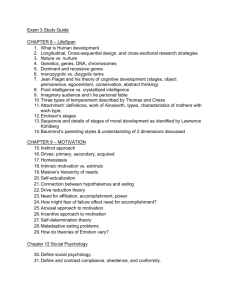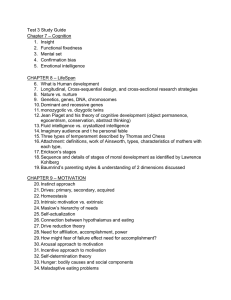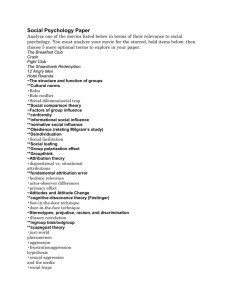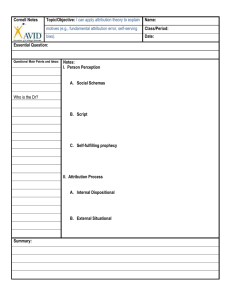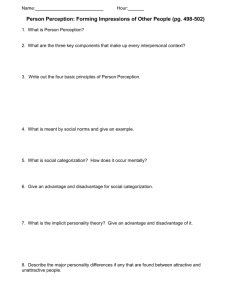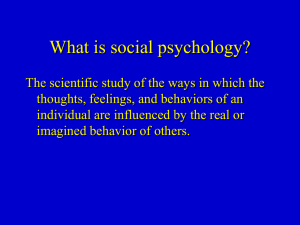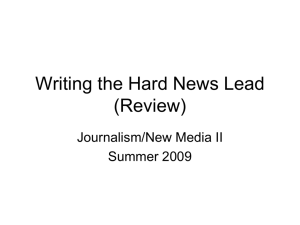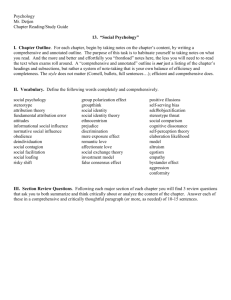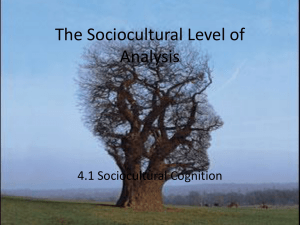Social Psychology
advertisement
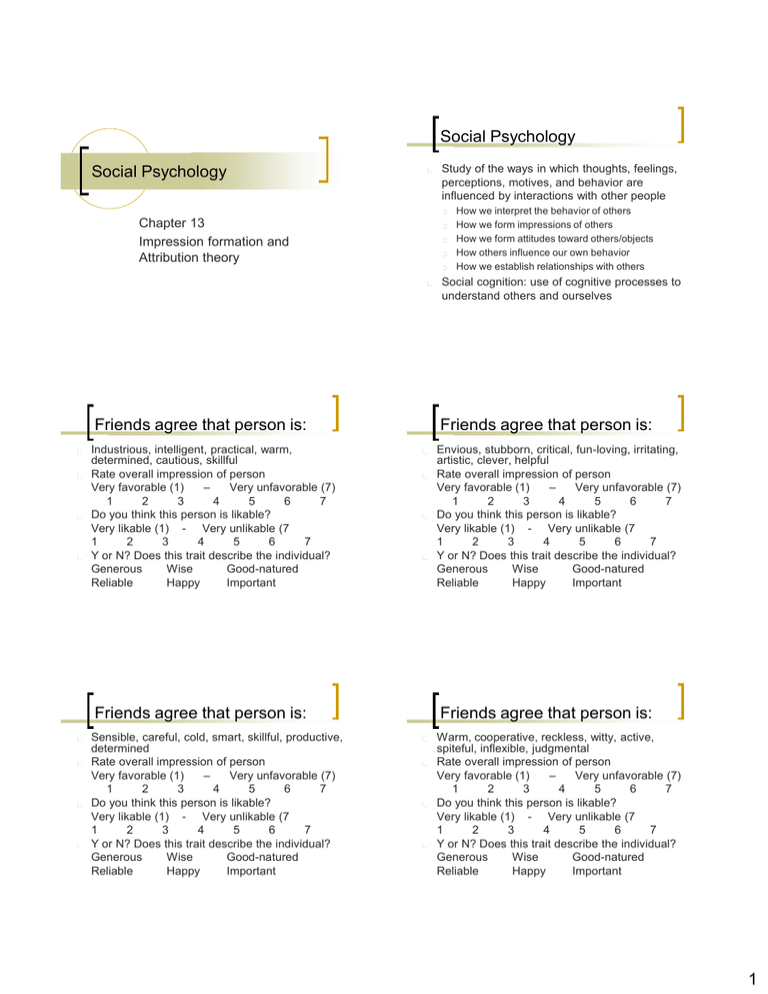
Social Psychology Social Psychology Chapter 13 Impression formation and Attribution theory Study of the ways in which thoughts, feelings, perceptions, motives, and behavior are influenced by interactions with other people How we interpret the behavior of others How we form impressions of others How we form attitudes toward others/objects How others influence our own behavior How we establish relationships with others Social cognition: use of cognitive processes to understand others and ourselves Friends agree that person is: Friends agree that person is: Industrious, intelligent, practical, warm, determined, cautious, skillful Rate overall impression of person Very favorable (1) – Very unfavorable (7) 1 2 3 4 5 6 7 Do you think this person is likable? Very likable (1) - Very unlikable (7 1 2 3 4 5 6 7 Y or N? Does this trait describe the individual? Generous Wise Good-natured Reliable Happy Important Envious, stubborn, critical, fun-loving, irritating, artistic, clever, helpful Rate overall impression of person Very favorable (1) – Very unfavorable (7) 1 2 3 4 5 6 7 Do you think this person is likable? Very likable (1) - Very unlikable (7 1 2 3 4 5 6 7 Y or N? Does this trait describe the individual? Generous Wise Good-natured Reliable Happy Important Friends agree that person is: Friends agree that person is: Sensible, careful, cold, smart, skillful, productive, determined Rate overall impression of person Very favorable (1) – Very unfavorable (7) 1 2 3 4 5 6 7 Do you think this person is likable? Very likable (1) - Very unlikable (7 1 2 3 4 5 6 7 Y or N? Does this trait describe the individual? Generous Wise Good-natured Reliable Happy Important Warm, cooperative, reckless, witty, active, spiteful, inflexible, judgmental Rate overall impression of person Very favorable (1) – Very unfavorable (7) 1 2 3 4 5 6 7 Do you think this person is likable? Very likable (1) - Very unlikable (7 1 2 3 4 5 6 7 Y or N? Does this trait describe the individual? Generous Wise Good-natured Reliable Happy Important 1 Impression formation Did a single word change overall impression? Did change in order of positive / negative traits change overall impression? Person perception First Impressions Serial position curve effects (primacy & recency) Anchor and adjustment heuristic Bottom up (features) 1. 2. 3. 4. Industrious, intelligent, practical, warm, determined, cautious, skillful Envious, stubborn, critical, fun-loving, irritating, artistic, clever, helpful Sensible, careful, cold, smart, skillful, productive, determined Warm, cooperative, reckless, witty, active, spiteful, inflexible, judgmental What happened to cause this event? Woman spills her coffee at a restaurant You get an “A” on the exam A student takes a semester off from school You get pulled over by a cop for speeding A Mom hits the bottom of child in the mall Someone cuts you off on the highway Student drops food tray in Burwell You miss class You pull an all-nighter before a paper is due President is caught plagiarizing his speeches Attribution theory Physical appearance Top down (schema) Social schema – influence of knowledge Infer elements that may not have been present Attribution How people make sense about their own and others’ behavior Inferences of cause and effect Try identify factors that give rise to outcomes Why do this? Make predictions about the future Process automatic and/or deliberate “Covariation model of attention” Do they always do this in this situation? Do others do this in this situation? Do they do they do this in other situations? Attribution bias Explain event by attributing behavior to: Internal attribution: Disposition or personality Behavior is due to person’s stable characteristics Can predict future behaviors External attribution: Situation or environment Behavior is due to outside forces Says little about future behaviors Good behavior Bad behavior Self Disposition Situation Other Situation Disposition 2 Biases in attribution Jones & Nisbett (1970s) Write 4 essays Actor-Observer bias Why do you/best friend like the person you date? Why did you/best friend choose your major? Own behavior – external Others behavior - internal Fundamental attribution error: Others’ behavior Overestimate internal factors Underestimate external situational factors Self-serving bias : Own behavior Success = internal Failure = external Self: more situational attributions (external) Best friend: more dispositional attributions (internal) Conclusions: Adaptive value vs. incorrect conclusions Jones & Harris (1967) Fundamental attribution error Use “it depends” more in reference to self Actor-Observer bias Interpretation of actor-observer difference Motivation Essay evaluation of either Pro or Anti-Castro Author chose/forced to take a side Guess author’s true attitude 70 60 Truly are pro-castro DV: code for internal/external attribution Results: Cognitive dissonance Behavior/belief at odds with self-concept; inconsistency Try to reduce it when possible Festinger & Carlsmith (1959) 50 Pro-Castro Anti-Castro 40 30 20 10 0 Choice No Choice Condition People tend to attribute action to internal factor Act in a way that contradicts true feeling/attitude IV: Paid $1 or $20 to lie (or no lie condition) DV: How enjoyable was the study Justification of effort Results… Festinger & Carlsmith (1959) Interpretation of actor-observer difference Cognitive dissonance enjoyable Cognitive interpretation would participate similar Know ourselves better than know others Know only one situation for others Less dispositional attributions when know person better (best friend) 1.5 1 0.5 Perceptual interpretation 0 -0.5 -1 control $1 $20 Different perspectives Can’t see what actor is responding to Can’t observe own behavior DV: Ratings from –5 to +5 3 Above-average effect (Harter, 1990) What are your strengths and weaknesses? College Board: 1 million HS students 70%: said above average on leadership 100%: above average for getting along with others 60% said above average in athletics People judge themselves as above-average on favorable characteristics Why? Thought paper Why do we make attribution errors? Can you think of a recent example of this type of error in your own life? Relate your example to the terms: Fundamental attribution error Actor-observer effect Self-serving bias Memory is selective Protect self-image of themselves and others Stereotypes Social Psychology Chapter 13 Stereotypes and prejudice Stereotypes Beliefs held about traits and behaviors that belong to a particular group and its members Most common: gender, race, age Prejudice Negative stereotype that leads people to negatively evaluate group members Emphasis on difference between groups Discrimination Prejudiced beliefs lead to behaviors Thought paper Blue-eyed / Brown-eyed movie: What did you learn about stereotypes and prejudice from the movie? What other comments, thoughts, or questions do you have about the movie? Sources of stereotypes and prejudice Schemas or heuristics Organize and reduce amount of information Social learning Conformity to a social norm Media Social and economic conflict Social categorization Scapegoating or blaming the innocent Dissimilarity and social distance Blue-eyed vs. Brown-eyed example http://www.pbs.org/wgbh/pages/frontline/shows/divided/etc/view.html 4 Effect of stereotypes and prejudice Self-fulfilling prophecies Beliefs cause the expected behavior Snyder, et al. (1977): phone study Stereotype threat Expectation IQ test performance affects final score Activation of negative stereotype Automatic activation of stereotype Stereotype activation on action Behavior can be triggered automatically Wegner’s white bear study Social behavior affected by unconscious thoughts Bargh, Chen, & Burrows (1996) Unscramble sentences about rudeness Flash words about aging interrupt faster walk slower Greenwald & Banaji (1995) (text pp435) Flash negative stereotypes about African Americans fictional character evaluated as more aggressive Are our thoughts and behaviors under our control? Combating prejudice Education Possibly the least effective tool People usually avoid or discount information New role models Discussion forums Repeated positive exposure Intergroup cooperation Legislation Thought paper What are the conclusions of Keating’s research? How are the conclusions different for children and adults? What does it tell us about attitude formation, persuasion, and leadership? Speak up against discriminatory behavior Examine your own beliefs – be aware! Control requires awareness and motivation Social influence Social Psychology Chapter 13 Influence and obedience How does others’ behavior or presence change behavior? Social facilitation: increase performance Triplett (1890’s): bicycle racers faster against others vs. clock Chicks peck faster in groups vs. alone Rats learn mazes faster in groups Social interference: Hinder performance 5 Bystander effect Altruism Kitty Genovese: 1964 How do people interpret situation? Ambiguity Fundamental attribution error Diffusion of responsibility Bystander effect The cost of helping others The benefit of helping others Deindividuation Asch’s Line Judgment Study Which line is the same length? Subject participates in a group of confederates Confederates give correct answers on first few trials Then all give same wrong answer If you could be invisible for a day, what would you do? Feel less accountable for behavior when in a group Loose sense of individuality? Large groups: Increases chances of socially unacceptable behavior “Crowd mentality” Conformity: social pressure Conformity Look to others for behavior and attitudes Go along with group even when know they are wrong Why? Cognitive: Want to be right More likely to conform if unsure Ally effect: no conformity if 1 other has their answer Motivational: Want to be liked Comparative function: Look to others for information about reality and we conform if unsure about our own judgment Fear ostracism from the group Avoid rejection 6 Power of authority: Milgram (1963) Recruited for study of “memory” White-coated experimenter: “examine effect of punishment on learning” Run subjects in pairs: “learner” and “teacher” Learner was confederate Teacher watches: learner get strapped to chair electrodes attached to wrist Power of authority: Milgram (1963) Milgram’s quote Teacher administered punishment when learner was incorrect (slight to severe shock) Increase punishment with each error If object to continuing: “You must go on.” How far do the participants go in obeying experimenter? Volt Reaction 75 Grunt 120 Shout in pain 150 Refuse to continue 200 Screams 300 No answer, heart 330+ Silence Milgram’s study of obedience “I observed a mature and initially poised businessman enter the laboratory smiling and confident. Within 20min he was reduced to a twitching, stuttering wreck, who was rapidly approaching nervous collapse. He constantly pulled on his ear lobe and twisted his hands. At one point he pushed his fist into his forehead and muttered “Oh God, lets stop it”. And yet he continued to respond to every word of the experimenter, and obeyed to the end.” Thought paper Percentage of partcipants obeying command at each shock level Why did 65% of the participants in the study deliver the highest level shock?! slight moderate strong very strong intense extremely intense danger: severe shock 65% willing to deliver highest level shock 450 volts 0 20 40 60 80 If you were to design a similar study, what variables would you change? Why? 100 7 Factors: Tendency to Obey Conformity High status of authority figure, prestige of Yale, for science Belief among subordinates that the source of the authority will be responsible for their actions – not them Strong tendency to obey direct commands Absence of a clear-cut point for switching to disobedience The gradual nature of many obedience situations (mild consequences at first – and only later are there harmful effects) Conclusion: Behavior not just due to personality – due to situation too Obedience Ethics of Milgram’s research? Participants mislead and were severely distressed Do the benefits outweigh the costs? Don’t think Milgram’s reasearch is “real”? McDonald’s story: “Police” phone in to strip-search employee http://abcnews.go.com/Primetime/story?id=1297922&page=1 http://abcnews.go.com/Primetime/story?id=1728839&page=1 http://www.courier-journal.com/apps/pbcs.dll/article?AID=/20051009/NEWS01/510090392 http://www.courier-journal.com/apps/pbcs.dll/article?AID=/20060316/NEWS01/603160403 http://www.msnbc.msn.com/id/15504125/ http://en.wikipedia.org/wiki/David_R._Stewart Attitudes Positive or negative beliefs Role in perception and interpretation Can affect behavior 3 components Cognitive What know/believe about object of attitude Affective The feelings the object produces Behavioral A predisposition to act in a certain way toward the object http://music.barnesandnoble.com/search/product.asp?userid=gT4w33JCOD&EAN=602498804803&ITM=1 How are attitudes formed? Exposure and repetition Zajonc (1968) Study photos 1x or up to 25x Estimate how much they liked person in pic More times shown -> more liked person Conditioning Classical conditioning: initial foundation Operant conditioning: influenced by rewards and punishments Observational learning Influenced by others – especially peers How to change attitudes? Elaboration likelihood model: 2 routes to persuasion Central Controlled processing Stable and long-lasting Peripheral Automatic processing More influenced by cues or mere exposure More influenced by source characteristics 8 Polarization of attitudes 9
